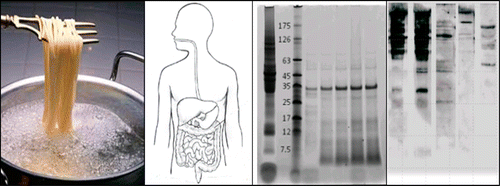Uncovering the effects of cooking, digestion on gluten and wheat allergens in pasta

Researchers trying to understand wheat-related health problems have found new clues to how the grain's proteins, including gluten, change when cooked and digested. They report in ACS' Journal of Agricultural and Food Chemistry that boiling pasta releases some of its potential allergens, while other proteins persist throughout cooking and digestion. Their findings lend new insights that could ultimately help celiac patients and people allergic to wheat.
Gianfranco Mamone and colleagues point out that pasta is one of the most popular foods in Europe and the U.S. Most people can eat it without a problem. But for those with wheat allergies or celiac disease, an autoimmune reaction to gluten, cutting the grain out of their diets is necessary to minimize symptoms. These symptoms can include abdominal pain, diarrhea and—in the long run—damage to the small intestines. Mamone's team set out to gain a better understanding of what happens to the potentially trouble-making proteins in pasta when it's cooked and consumed.
In the lab, the researchers cooked store-bought pasta and simulated how the body would digest it. They found that while some gluten proteins persisted throughout the cooking and digestion process, other allergenic non-gluten proteins are lost during boiling as they almost completely leak into the cooking water. This suggests that for people with particular types of wheat allergies unrelated to celiac disease, eating pasta might cause a weaker reaction than wheat products that are baked, the researchers say. Their findings also contribute to understanding the chemistry of gluten digestion.
More information: Tracking the Fate of Pasta (T. durum Semolina) Immunogenic Proteins by in Vitro Simulated Digestion, J. Agric. Food Chem., Article ASAP. DOI: 10.1021/jf505461x
Abstract
The aim of the present study was to identify and characterize the celiacogenic/immunogenic proteins and peptides released during digestion of pasta (Triticum durum semolina). Cooked pasta was digested using a harmonized in vitro static model of oral–gastro–duodenal digestion. The course of pasta protein digestion was monitored by SDS-PAGE, and gluten proteins were specifically analyzed by Western blot using sera of celiac patients. Among the allergens, nonspecific lipid-transfer protein was highly resistant to gastro–duodenal hydrolysis, while other digestion-stable allergens such as α-amylase/trypsin inhibitors were not detected being totally released in the pasta cooking water. To simulate the final stage of intestinal degradation, the gastro–duodenal digesta were incubated with porcine jejunal brush-border membrane hydrolases. Sixty-one peptides surviving the brush-border membrane peptidases were identified by liquid chromatography–mass spectrometry, including several gluten-derived sequences encrypting different motifs responsible for the induction of celiac disease. These results provide new insights into the persistence of wheat-derived peptides during digestion of cooked pasta samples.
Journal information: Journal of Agricultural and Food Chemistry
Provided by American Chemical Society



















